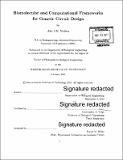| dc.contributor.advisor | Christopher A. Voigt. | en_US |
| dc.contributor.author | Nielsen, Alec A. K | en_US |
| dc.contributor.other | Massachusetts Institute of Technology. Department of Biological Engineering. | en_US |
| dc.date.accessioned | 2017-06-06T19:24:15Z | |
| dc.date.available | 2017-06-06T19:24:15Z | |
| dc.date.copyright | 2017 | en_US |
| dc.date.issued | 2017 | en_US |
| dc.identifier.uri | http://hdl.handle.net/1721.1/109665 | |
| dc.description | Thesis: Ph. D., Massachusetts Institute of Technology, Department of Biological Engineering, 2017. | en_US |
| dc.description | Page 322 blank. Cataloged from PDF version of thesis. | en_US |
| dc.description | Includes bibliographical references (pages 295-321). | en_US |
| dc.description.abstract | Living cells naturally use gene regulatory networks termed "genetic circuits" to exhibit complex behaviors such as signal processing, decision-making, and spatial organization. The ability to rationally engineer genetic circuits has applications in several biotechnology areas including therapeutics, agriculture, and materials. However, genetic circuit construction has traditionally been time- and labor-intensive; tuning regulator expression often requires manual trial-and-error, and the results frequently function incorrectly. To improve the reliability and pace of genetic circuit engineering, we have developed biomolecular and computational frameworks for designing genetic circuits. A scalable biomolecular platform is a prerequisite for genetic circuits design. In this thesis, we explore TetR-family repressors and the CRISPRi system as candidates. First, we applied 'part mining' to build a library of TetR-family repressors gleaned from prokaryotic genomes. A subset were used to build synthetic 'NOT gates' for use in genetic circuits. Second, we tested catalytically-inactive dCas9, which employs small guide RNAs (sgRNAs) to repress genetic loci via the programmability of RNA:DNA base pairing. To this end, we use dCas9 and synthetic sgRNAs to build transcriptional logic gates with high on-target repression and negligible cross-talk, and connected them to perform computation in living cells. We further demonstrate that a synthetic circuit can directly interface a native E. coli regulatory network. To accelerate the design of circuits that employ these biomolecular platforms, we created a software design tool called Cello, in which a user writes a high-level functional specification that is automatically compiled to a DNA sequence. Algorithms first construct a circuit diagram, then assign and connect genetic "gates", and simulate performance. Reliable circuit design requires the insulation of gates from genetic context, so that they function identically when used in different circuits. We used Cello to design the largest library of genetic circuits to date, where each DNA sequence was built as predicted by the software with no additional tuning. Across all circuits 92% of the output states functioned as predicted. Design automation simplifies the incorporation of genetic circuits into biotechnology projects that require decisionmaking, control, sensing, or spatial organization. | en_US |
| dc.description.statementofresponsibility | by Alec A.K. Nielsen. | en_US |
| dc.format.extent | 322 pages | en_US |
| dc.language.iso | eng | en_US |
| dc.publisher | Massachusetts Institute of Technology | en_US |
| dc.rights | MIT theses are protected by copyright. They may be viewed, downloaded, or printed from this source but further reproduction or distribution in any format is prohibited without written permission. | en_US |
| dc.rights.uri | http://dspace.mit.edu/handle/1721.1/7582 | en_US |
| dc.subject | Biological Engineering. | en_US |
| dc.title | Biomolecular and computational frameworks for genetic circuit design | en_US |
| dc.type | Thesis | en_US |
| dc.description.degree | Ph. D. | en_US |
| dc.contributor.department | Massachusetts Institute of Technology. Department of Biological Engineering | |
| dc.identifier.oclc | 988326433 | en_US |
